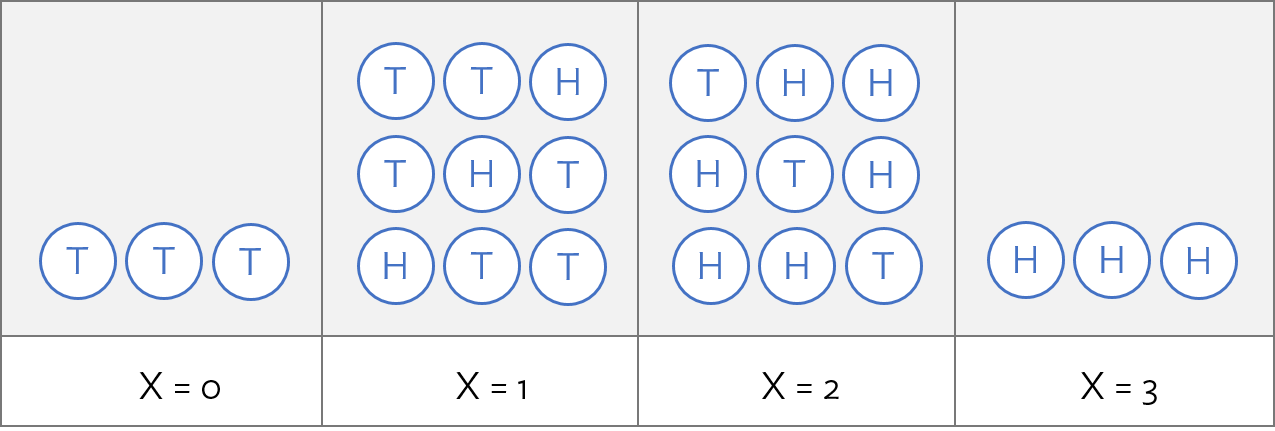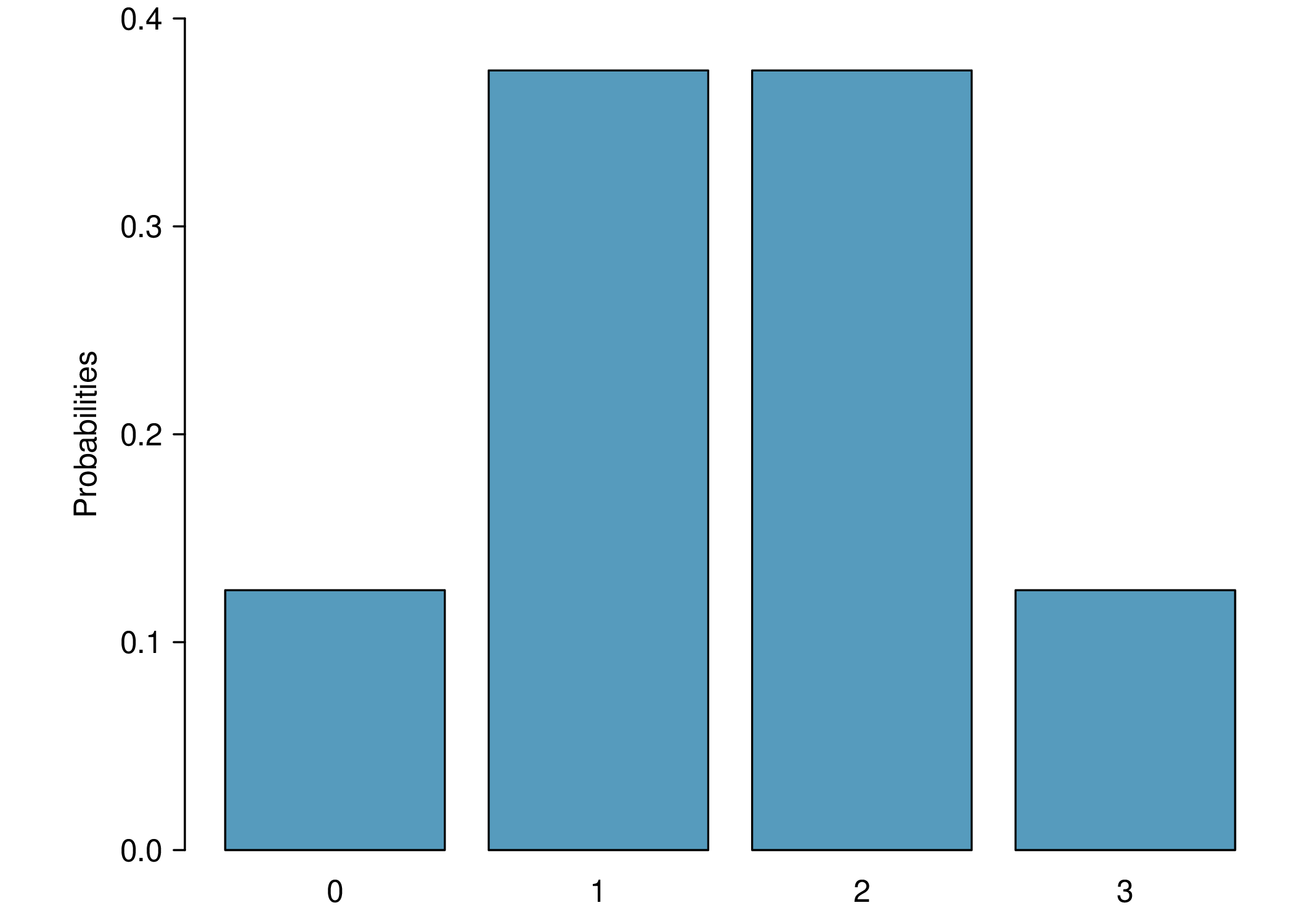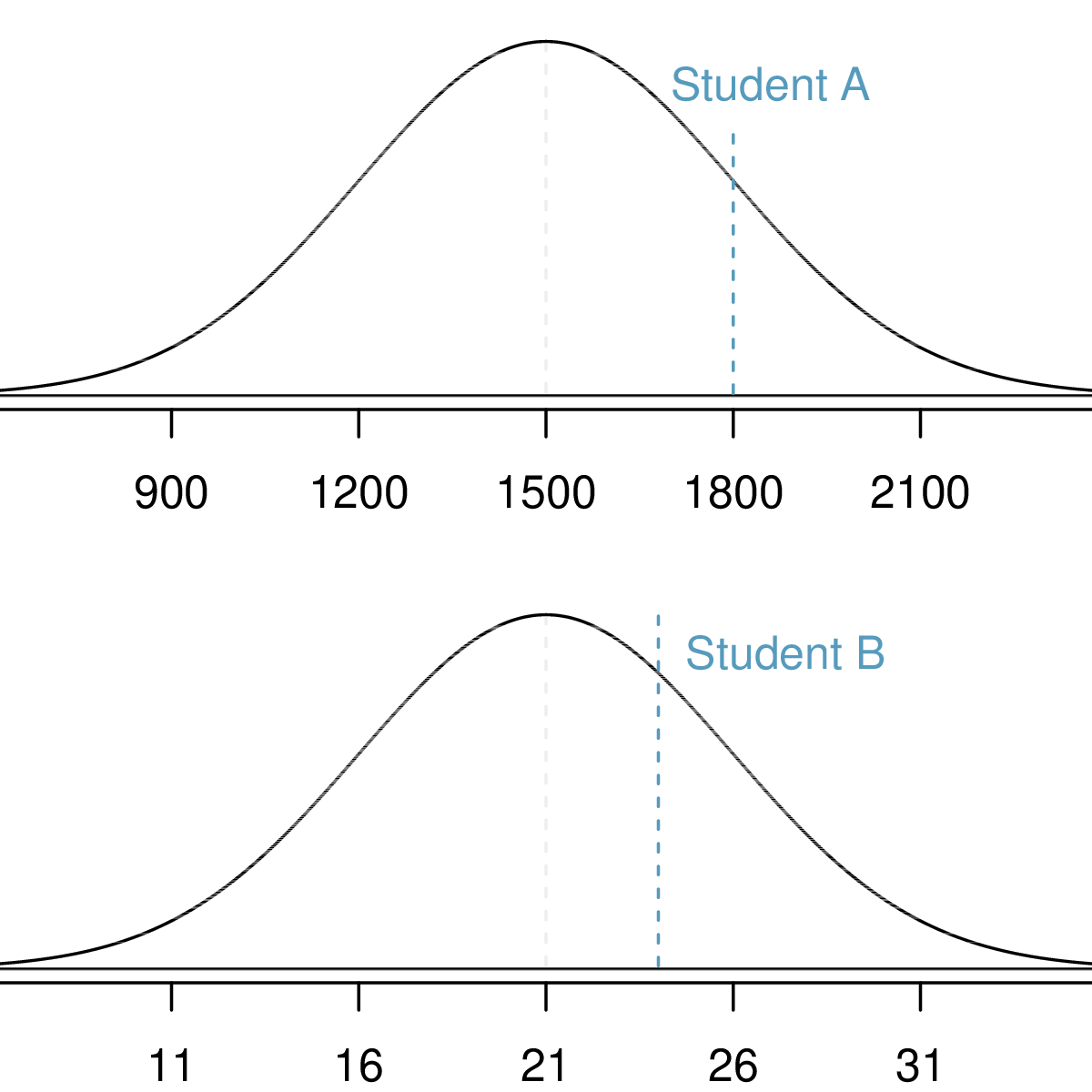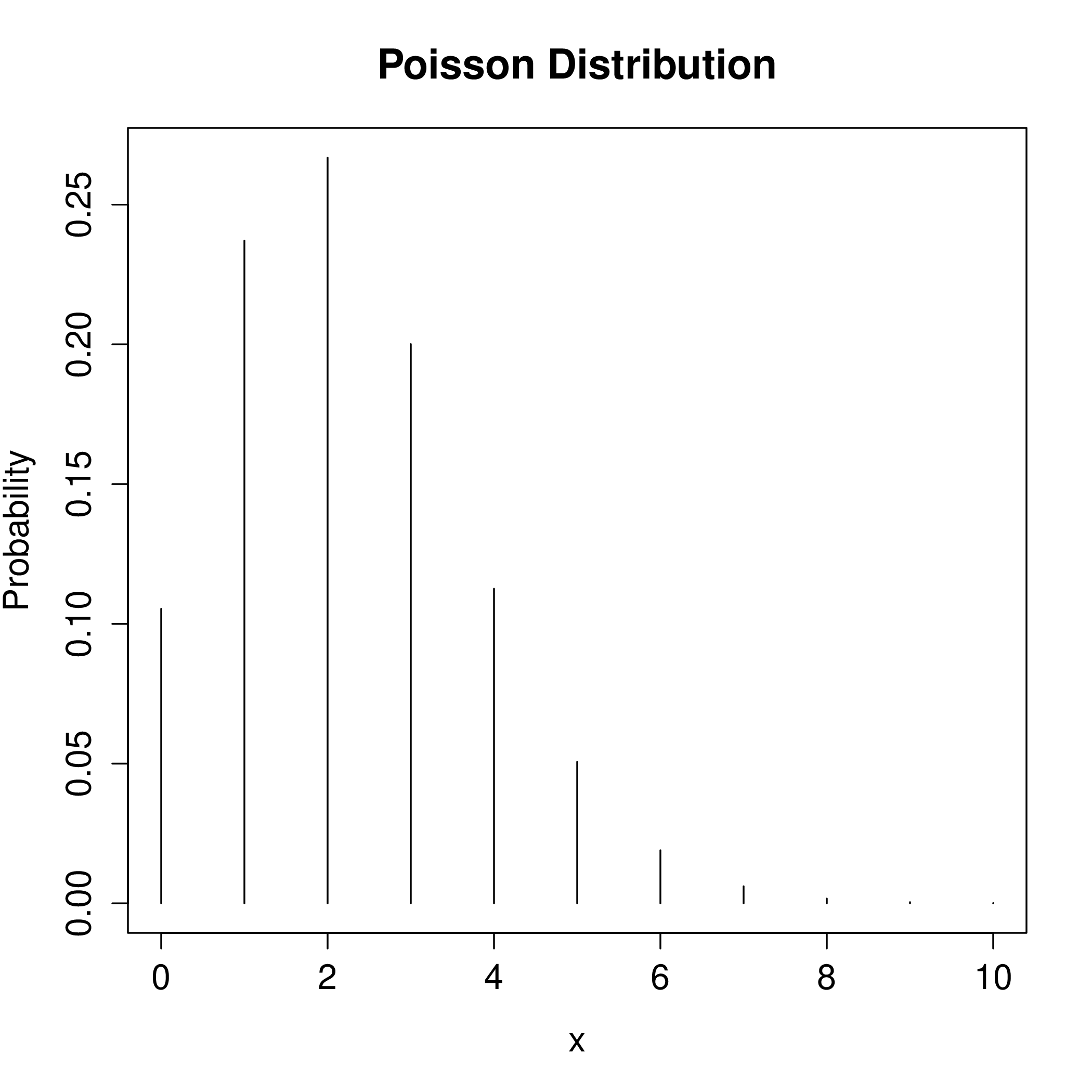[1] 0.8413447Random Variables and Probability Distributions
September 3, 2025
Basic Concepts About Random Variables
- Definition of a random variable
- Distributions of random variables
- Properties of operations on random variables
- expectation
- (co)variance
- standard deviation
Definition of a Random Variable
A random variable (RV) is a function that maps each event in a sample space
A discrete random variable takes on a finite number of values.
- Suppose

Distribution of a Discrete Random Variable
The distribution of a discrete RV is the collection of its values and the probabilities associated with those values.
The probability distribution for
| 0 | 1 | 2 | 3 | |
|---|---|---|---|---|
| 1/8 | 3/8 | 3/8 | 1/8 |
For the distribution to be well-defined, we need that
Example Discrete Distribution of

Expectation of a Random Variable
Let
Sometimes,
Calculating an Expectation
Returning to our coin tossing example,
Linearity of Expectation
The expectation operator
This turns out to be a very useful property. Intuitively, this follows from the expectation being summation (or integration) operation.
Variance of a Random Variable
Let
Calculating the Variance of a Random Variable
Again returning to our coin tossing example,
The standard deviation is
Variance and Expectation
Note that
As noted before, if we define
Covariance of Two Random Variables
For two RVs,
The covariance is tied to another notion—correlation, which we will discuss later in a module on regression analysis.
Binomial Random Variables
A specific type of discrete RV is a binomial RV.
- Each replicate has two possible outcomes: success or failure
- The probability of success
Binomial Random Variables
A binomial RV takes on values
For example, the number of heads in 3 tosses of a fair coin is a binomial RV with parameters
For a binomial RV
The Binomial Coefficient
The binomial coefficient
Mathematically,
- For any integer
Formula for the Binomial Distribution
Let
Calculating Binomial Probabilities in R
The function dbinom() is used to calculate
dbinom(k, n, p):
The function pbinom() is used to calculate
pbinom(k, n, p):pbinom(k, n, p, lower.tail = FALSE):
Continuous Random Variables
A discrete random variable takes on a finite number of values.
- Number of heads in a
- Number of people who’ve had chicken pox in a random sample
A continuous random variable takes on any value in an interval.
- Height in a population
- Blood pressure in a population
Discrete RVs are counted, continuous RVs are measured.
Probabilities from Continuous Distributions
Two important features of continuous distributions:
- The total area under the density curve is 1.
- The probability that a variable has a value within a specified interval is the area under the curve over that interval.

Probabilities from Continuous Distributions
When working with continuous random variables, probability is found for intervals of values rather than individual values.
- Formally, the probability that a continuous RV
- Thus,
The “Empirical Rule” for the Normal Distribution
According to the “empirical rule,” for any1 normal distribution,
- approximately 68% of the data are within 1 SD of the mean
- approximately 95% of the data are within 2 SDs of the mean
- approximately 99.7% of the data are within 3 SDs of the mean
The “Empirical Rule” for the Normal Distribution

An Example of Using a Normal Distribution
Assume that the distributions of test scores on the SAT and ACT are normal with means
Suppose that one student scores an 1800 on the SAT (Student A) and another student scores a 24 on the ACT (Student B). Which student performed better?

Standard Normal Distribution
A standard normal distribution is defined as a normal distribution with mean 0 and variance 1. It is often denoted as
Any normal random variable
Example of Using a Normal Distribution
- SAT scores are
Calculating Probabilities from Normal Distributions
What is the percentile rank for a student who scores an 1800 on the SAT for a year in which the scores are
Calculate a
pnorm(z)gives the area (i.e., probability) to the left ofAlternatively, let
Rdo the work…
Calculating Probabilities from Normal Distributions
What score on the SAT would put a student in the 99th percentile?
Identify the
qnorm(p)calculates the valueIf
Alternatively, let
Rdo the work …
Words of Warning…
“Everyone is sure of this [that errors are normally distributed]…since the experimentalists believe that it is a mathematical theorem, and the mathematicians that it is an experimentally determined fact.” –Poincaré (1912)
“Far better an approximate answer to the right question, which is often vague, than the exact answer to the wrong question, which can always be made precise.” –Tukey (1962)
The Poisson Distribution
The Poisson distribution is used to calculate probabilities for rare events that accumulate over time (but is often used for counts).
It used most often in settings where events happen at a rate
- Typical example: for children ages 0-14, the incidence rate of acute lymphocytic leukemia (ALL) was about 30 diagnosed cases per million children per year in the decade 2000-2010.
- Always important to note and understand the units.
Example: Outbreaks of Childhood Leukemia
Fortunately, childhood cancers are rare.
For children ages 0-14, the incidence rate of acute lymphocytic leukemia (ALL) was approximately 30 diagnosed cases per million children per year in the decade from 2000-2010. Given that about 20% of the US population are in this age range, we may ask
- What is the incidence rate of ALL over a 5 year period?
- In a small city of 75,000 people, what is the probability of observing exactly 8 cases of ALL over a 5 year period?
- In the small city, what is the probability of observing 8 or more cases of ALL over a 5 year period?
Poisson Distribution
Suppose events occur over a fixed time window in such a way that
- The probability an event occurs in an interval is proportional to the length of the interval.
- Events occur independently at a rate
Poisson Distribution
Then the probability of exactly
- The mean is
- The standard deviation is
Poisson Distribution
The probability of exactly
- The mean is
- The standard deviation is
Poisson Distribution with

Childhood Leukemia Incidence
See Example 3.37 of Vu and Harrington (2020) for details.
What is the incidence rate of ALL over a 5 year period?
Incidence rate of ALL in a year is 30 cases per 1,000,000 children:
Incidence rate in a 5-year period is (5)(30) per 1,000,000 children:
…and what about a city of size 75,000?
In a small city of 75,000 people, what is the probability of observing exactly 8 cases of ALL over a 5 year period?
In a city of 75,000 people, about
The five-year rate of new cases for the whole city would be
What is the probability of 8 cases over 5 years?
In a small city, what is the probability of observing 8 or more ALL cases in a 5-year period?
Easiest to calculate this in R. To do so, suppose dpois(k, lambda) gives
…but what is the probability of 8 or more cases?
In a small city, what is the probability of observing 8 or more ALL cases in a 5 year period?
Would 8 or more cases be a rare event? Suppose
Compute ppois(k, lambda)
Or ppois(k, lambda, lower.tail = FALSE)
Summary Table of Distributions
| Binomial | Normal | Poisson | |
|---|---|---|---|
| Parameters | |||
| Possible values | (- |
||
| Mean | |||
| Standard Deviation |
References

HST 190: Introduction to Biostatistics